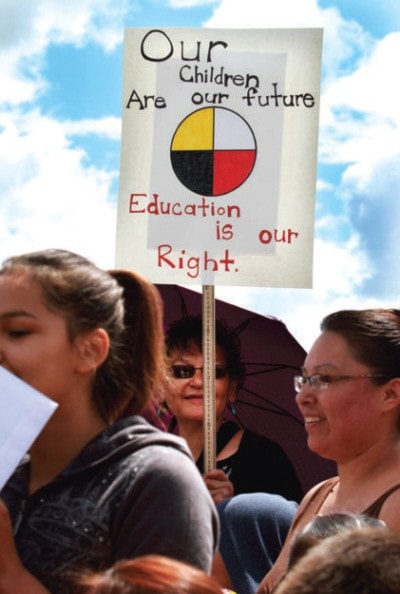Federal and provincial governments appear to be at a standoff over who should pay for the healthcare of First Nations children with severe special needs.
One such case involved Jordan River Anderson, a First Nations child born with a rare neuromuscular disorder and required hospitalization from birth. Anderson’s case was so severe that he would not live for long but the federal government and the Province of Manitoba could not agree on who would pay for his home care.
He was not allowed to leave the hospital until they could determine who was responsible.
Anderson died in the hospital in 2005 before the governments could come to an agreement. To battle this issue, Jordan’s Principle was adopted unanimously in the House of Commons Dec. 12, 2007.
This principle takes a “child-first” approach that states care is given to a First Nations child and the governments can settle payment at a later time.
Since its adoption almost seven years ago, no First Nations children have been classified under the principle.
Maskwacis community seeks change
Young students with the Nipisihkopahk Education Authority in Maskwacis rallied together June 11 to raise awareness of the issue and write 490 letters to Prime Minister Stephen Harper and Wetaskiwin MP Blaine Calkins.
Organizer Tashia Swampy is a practicum student who was inspired by the story of Jordan’s Principle and she feels young people can bring about change.
“It took my heart and I totally dedicated my practicum to organizing this walk,” said Swampy.
She says the main purpose of the walk was to educate people on the issues First Nations children face in Canada.
“There’s a huge inequality gap between our First Nations children and the children that are not First Nation,” stated Swampy.
Students walked from the Samson Bingo Hall to the post office on at the Ermineskin Mall. A portion of Highway 2A was blocked to allow safe walking for students and Maskwacis RCMP provided a police escort.
Maskwacis community speaks out
Luci Johnson, a First Nations co-ordinator with Alberta Health Services, says the Maskwacis community is challenging Canada’s government over a lack of action.
“Right now there is not one case across Canada that says there is a child in need under Jordan’s Principle,” explained Johnson.
She wonders why there are no children under this classification when Noah Buffalo, a 12-year-old Maskwacis boy with severe Cerebral Palsy has ongoing issues receiving care.
Education inequalities pose other challenges for First Nations students and Johnson said the walk was also a reminder to advocate equal education opportunities for First Nations children.
Kevin Wells, Nipisihkopahk Education Authority (NEA) superintendent feels supporting the walk is important for students. “It empowers them to know each and every one of them can bring a change in this country.”
“Often we think the power is in the government and not necessarily in the people,” Wells added.
Samson Cree Coun. Vern Saddleback feels Jordan’s Principle is important as it states childcare is more important than who is supposed to pay for it. “It’s what the whole walk is about.
“It’s just this big funding inequity…that affect children,” he added.
Funding available off the reserve
Six years after Jordan’s Principle was adopted, not a single First Nations child has been placed care under this guidance.
Noah’s mother Carolyn Buffalo says this issue sits close to home for her.
She says she has had to fight both governments every step of the way to gain support for Noah. Valued items such as a motorized wheelchair are not easy to get. “I had to fight for everything.”
Buffalo was in Ottawa when the principle was established and had tears running down her eyes at that time. “It was a real powerful moment.”
She has been told that getting funding or support is not an issue as long as she lives off the reserve, but Buffalo said when she speaks to Health Canada, they say these programs are provincial and out of their jurisdiction.
Buffalo feels there is a myth that First Nations have more money and funding than non-aboriginal people. “What happens is, when you live on the reserve you have less services and you have no access to programs and services that you would have off-reserve.”
For Buffalo, Jordan’s Principle has been just that, a principle.
“It hasn’t made a damn difference,” she said.
Slow action by bureaucrats in both levels of government is causing issues for aboriginal children and families, explained Buffalo. She says each side comes up with the same position that the other party will have to foot the bill while the other won’t.
“Our children are still suffering and some of them are dying and families have to move off reserve in order to have access to services,” stated Buffalo.
She still lives on the reserve but knows parents who have put their children in care in order to access needed services.
“How is it good public policy to deny handicapped children, who are the most defenseless and voiceless, to deny them access to programs and services and adequate funding?” she asked.
Buffalo has a human rights complaint that has been submitted to the government.
Swampy says she chose June 11 for the walk as it is the fourth anniversary of Prime Minister Stephen Harper’s apology to former students of Indian residential schools.
Jordan’s family has filed a lawsuit against the Federal Government in 2007 and Swampy said they expect to hear an answer in October.
